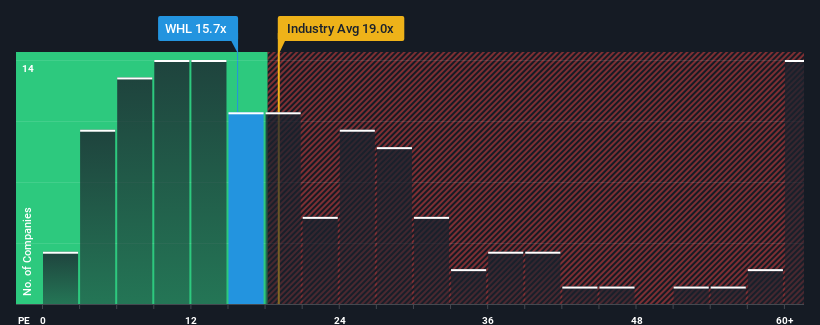Subdued Growth No Barrier To Woolworths Holdings Limited's (JSE:WHL) Price
When close to half the companies in South Africa have price-to-earnings ratios (or "P/E's") below 8x, you may consider Woolworths Holdings Limited (JSE:WHL) as a stock to avoid entirely with its 15.7x P/E ratio. Although, it's not wise to just take the P/E at face value as there may be an explanation why it's so lofty.
With earnings growth that's superior to most other companies of late, Woolworths Holdings has been doing relatively well. It seems that many are expecting the strong earnings performance to persist, which has raised the P/E. If not, then existing shareholders might be a little nervous about the viability of the share price.
See our latest analysis for Woolworths Holdings

Is There Enough Growth For Woolworths Holdings?
There's an inherent assumption that a company should far outperform the market for P/E ratios like Woolworths Holdings' to be considered reasonable.
If we review the last year of earnings growth, the company posted a terrific increase of 15%. The latest three year period has also seen an excellent 637% overall rise in EPS, aided by its short-term performance. Accordingly, shareholders would have probably welcomed those medium-term rates of earnings growth.
Looking ahead now, EPS is anticipated to climb by 8.1% per annum during the coming three years according to the six analysts following the company. Meanwhile, the rest of the market is forecast to expand by 11% per annum, which is noticeably more attractive.
With this information, we find it concerning that Woolworths Holdings is trading at a P/E higher than the market. Apparently many investors in the company are way more bullish than analysts indicate and aren't willing to let go of their stock at any price. There's a good chance these shareholders are setting themselves up for future disappointment if the P/E falls to levels more in line with the growth outlook.
The Key Takeaway
Using the price-to-earnings ratio alone to determine if you should sell your stock isn't sensible, however it can be a practical guide to the company's future prospects.
We've established that Woolworths Holdings currently trades on a much higher than expected P/E since its forecast growth is lower than the wider market. When we see a weak earnings outlook with slower than market growth, we suspect the share price is at risk of declining, sending the high P/E lower. This places shareholders' investments at significant risk and potential investors in danger of paying an excessive premium.
Don't forget that there may be other risks. For instance, we've identified 1 warning sign for Woolworths Holdings that you should be aware of.
If you're unsure about the strength of Woolworths Holdings' business, why not explore our interactive list of stocks with solid business fundamentals for some other companies you may have missed.
Valuation is complex, but we're here to simplify it.
Discover if Woolworths Holdings might be undervalued or overvalued with our detailed analysis, featuring fair value estimates, potential risks, dividends, insider trades, and its financial condition.
Access Free AnalysisHave feedback on this article? Concerned about the content? Get in touch with us directly. Alternatively, email editorial-team (at) simplywallst.com.
This article by Simply Wall St is general in nature. We provide commentary based on historical data and analyst forecasts only using an unbiased methodology and our articles are not intended to be financial advice. It does not constitute a recommendation to buy or sell any stock, and does not take account of your objectives, or your financial situation. We aim to bring you long-term focused analysis driven by fundamental data. Note that our analysis may not factor in the latest price-sensitive company announcements or qualitative material. Simply Wall St has no position in any stocks mentioned.
About JSE:WHL
Woolworths Holdings
Through its subsidiaries, operates a chain of retail stores in South Africa, Australia, and New Zealand.
Adequate balance sheet with moderate growth potential.
Similar Companies
Market Insights
Community Narratives




